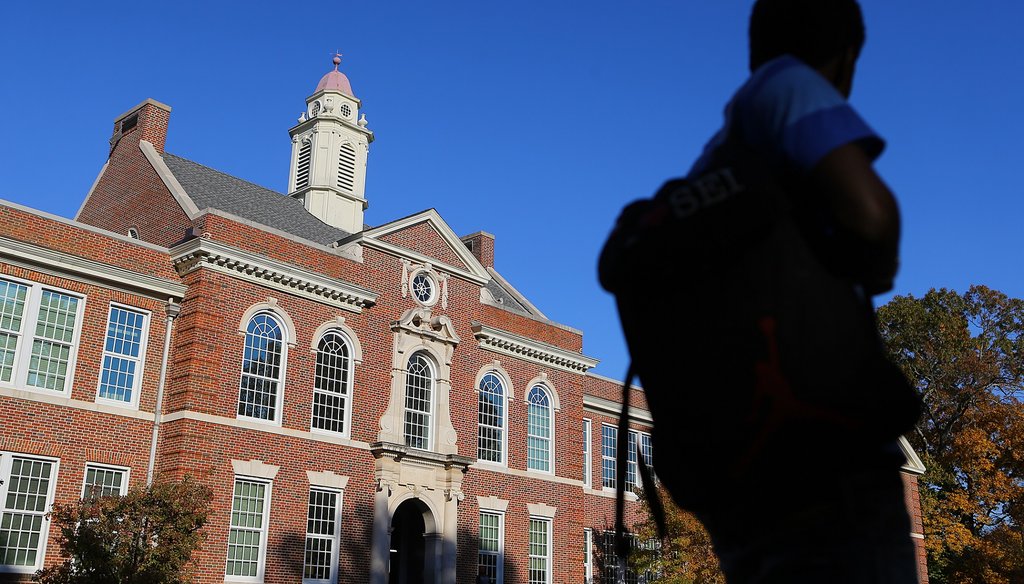



A student walks by Druid Hills High School in November. The school is in a neighborhood considering annexation into Atlanta. Photo by Curtis Compton / AJC.
Atlanta may have been founded as the end of the line, but it has hardly held to that designation.
Founded in 1847, Atlanta’s original city limits were a single-mile radius around the Zero Mile Post, or terminus of the Western & Atlantic Railroad.
Today, the city covers nearly 132 square miles of land stretched out over two counties. Terminus is little more than a marker next to the southern entrance of Underground Atlanta (and a particularly distasteful safe haven for "The Walking Dead" fans).
With two more communities on the edges of the city debating whether to join Atlanta, one city councilwoman was quoted in an Atlanta Journal-Constitution story talking about what recent annexations meant for the city.
"You brought in a mayor with the last annexation," District 11 Councilwoman Keisha Lance Bottoms said of Mayor Kasim Reed, referring to the 2006 annexation of what is now known as southwest Atlanta.
Is that right, that growing Atlanta’s borders created the opportunity for Reed, a former state senator, to become Atlanta’s 59th mayor? The AJC Truth-O-Meter spun back in time to find out.
The city’s Geographic Information Systems department keeps detailed maps of Atlanta’s 133 annexations.
All but 18 of those actions have been to grow the city, including the massive addition of Buckhead and Lakewood in 1952.
One of the outliers was a decision to hold off on annexing Sandtown in 2006. That south Fulton community, along with the DeKalb County sections of the historic Druid Hills community, is now weighing whether to join Atlanta.
If there is another round of annexations, it will be the first changing of the city’s borders since 2007, when Atlanta absorbed three Southside subdivisions.
Bottoms, though, said she was referring to the much larger 2006 annexation that brought in about 2,000 residents from then-newly developed subdivisions along Cascade Road as it passes south and west out of the city.
The councilwoman herself has lived in that area, also known as Midwest Cascade, since the mid-1990s. She was active in her subdivision’s homeowners association when the community was part of unincorporated Fulton County. The annexation paved the way for her to run for the council, where she has served since 2010.
Reed was sworn in that same year. PolitiFact Georgia recently ruled Mostly True that Reed’s first term was marked by keeping campaign promises such as a major pension overhaul and hiring more police officers.
"We both lived in the same area, in two different neighborhoods," Bottoms said. "Annexation meant there was an opportunity for people who had lived there to run for city office and get involved."
Reed has said he supports annexing Druid Hills from DeKalb County and Sandtown in south Fulton, if those residents seek to join the city.
But that is not because the former state senator – who represented pieces of unincorporated Fulton and Atlanta during his legislative tenure – was exactly the beneficiary of annexation the way that Bottoms described.
Reed lived in Loch Lochman Estates during the 2006 annexation. That subdivision is literally down the street from what became Atlanta – but it was not included in the expansion. Today, it remains part of the unincorporated county.
But Reed’s spokeswoman said that annexation did prompt him to move to Midwest Cascade, where he still lives.
"He moved, but he is in the same neighborhood," spokeswoman Anne Torres said. "So the councilwoman is right to say that annexation did bring him in."
So where does that leave us?
We won’t quibble with Bottoms’ reference to the last annexation, considering the small size of the 2007 additions.
She is not quite right on her claim that the larger 2006 annexation included Reed’s subdivision, which opened the door to his candidacy.
The mayor’s office said, though, that the move did push him to a different house in the same neighborhood so he could be a city resident. To that end, her point is correct.
There is some additional context needed to make sense of it all. But overall, we rate the claim Mostly True.
The Atlanta Journal-Constitution, "Atlanta council weighs in on annexation possibilities," Nov. 28, 2014
GeorgiaInfo, Fulton County Historical Markers, accessed Dec. 2, 2014
City of Atlanta Geographic Information Systems, City of Atlanta annexations, accessed Dec. 2, 2014
City of Atlanta, Annexation Service Plan, Midwest Cascade Area, Sept. 14, 2006
Interview with Keisha Lance Bottoms, Atlanta City Councilwoman, Dec. 2, 2014
Interview with Anne Torres, spokeswoman for Atlanta Mayor Kasim Reed, Dec. 2, 2014
In a world of wild talk and fake news, help us stand up for the facts.
